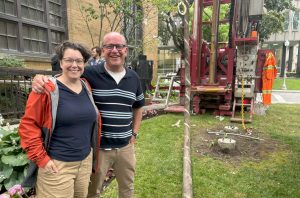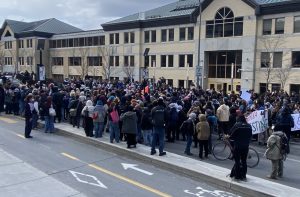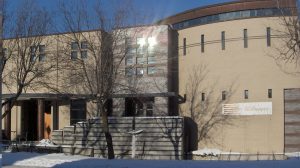When Montreal writer Taras Grescoe first thought to write a non-fiction book about life in Shanghai in the 1930s, he never imagined it would end up having such a strong Jewish connection.
In his recently published Shanghai Grand, a surprisingly high number of the people in the book − including two of its three main protagonists − are Jewish, along with various references to Jewish subjects.
Based on extensive research that included visits to Shanghai, Grescoe presents a compelling portrait of what was then known as “the wicked old Paris of the East.” The city’s large foreign-controlled enclave was home to many adventurers and bon vivants from western countries.
“It was a place to which the ambitious, the wily and the desperate could escape to discard old identities and recreate their lives from scratch,” Grescoe writes early in the book.
People were attracted by the cosmopolitan glamour and hedonism. Following Hitler’s Kristallnacht pogrom in 1938 and during World War II, when countries refused to accept Jews fleeing the Nazis, Shanghai became “the port of last resort” for 20,000 Jewish refugees escaping Europe.
The book is rich in intrigue, drama and colourful characters. Two have Canadian and Jewish links: Morris “Two-Gun” Cohen, a close aide to Chinese revolutionary Sun Yat-Sen, and Trebitsch Lincoln, an international con man.
At the heart of the book is an unusual three-sided love story between British real estate mogul Sir Victor Sassoon, swashbuckling American writer Emily (Mickey) Hahn and Chinese poet Zau Sinmay.
Events play out against growing turmoil and squalor among local Chinese as war and revolution loom ominously on the horizon, inevitably piercing the bubble in which the expatriates live. In 1937, Japan occupied Shanghai while Chinese communists led by Mao Zedong battled nationalists led by Chiang Kai-Shek for control of their country.
Grescoe, who is not Jewish, was born in Toronto and grew up in Calgary and Vancouver. He moved to Montreal in 1996 after also living in Paris. Shanghai Grand is his sixth non-fiction book and the first to have such pronounced Jewish content.
Grescoe, 49, can often be found at his café of choice, Club Social, near his home in Montreal’s hip Mile End neighbourhood. That’s where I first spoke to him about Shanghai Grand.
When you began researching the book, did you anticipate it having so many Jewish characters?
I knew from the start that two key characters in the story were Jewish. Emily “Mickey” Hahn was born to a German Jewish family in St. Louis, and Sir Victor Sassoon was part of an illustrious Sephardic dynasty that traced its ancestry back to King David. I was surprised, however, at just how many of the subordinate figures – outlandish adventurers, idealistic dreamers, selfless heroes, and yes, a fair share of scoundrels – turned out to be Jewish.

Why were there so many Jews in Shanghai, even before refugees arrived from Nazi Europe?
In the 1930s, the city had the largest Jewish population in the Far East. The Treaty Port of Shanghai was founded in 1842 by the English, French, and Americans, after the First Opium War. But the first entrepreneurs to really understand the city’s potential due to its strategic location and access to a large population were Sephardic Jews from the Middle East. Among them were the Sassoons, Hardoons and Kadoories, who thrived in the opium, cotton and, eventually, the real estate business. Then, Russian Jews came after the Soviet Revolution.
Was there much sympathy between the Chinese and the Jews in Shanghai?
I was surprised to learn China had a Jewish community as far back as the 10th-century CE. But for the most part, Jews were an unknown quantity to the Chinese, which meant anti-Semitism was a foreign concept.
Those who knew something about Jews (usually wealthy or educated Chinese) associated Judaism with business acumen.
For the common Chinese, especially those in Hongkou, the site of the World War II ghetto in Shanghai [established by the Japanese occupiers at the request of their Nazi allies], the Jews were just neighbours, and they tended to get along. The overall impression you get is of people, Chinese and Jews, thrown together in poverty, but willing to laugh together, work alongside one another, and help one another.
And we shouldn’t forget the extraordinary “Schindler of China,” Ho Feng Shan, who used his position at the Nationalist Chinese consulate in Vienna to write thousands of transit visas for Shanghai. He’s the one who alerted European Jewry to the fact that Shanghai was a free port, open to all comers with the requisite funds. Despite opposition from his superiors, he saved at least 5,000 Jews.

After working on the book, did your perception of Jews change?
Characters like Mickey Hahn and Vicki Baum made me reflect on the interesting status of Jews in the Diaspora. As outsiders from gentile culture, they were put in a position to be observers and chroniclers. They could function in the dominant culture, and often thrive, but they remained distinct. Their marginalization, even if it was subtle, gave them a fresh outlook.
The majority of the writers who have had an influence on me have been Jewish, and outsiders in their own communities. Franz Kafka in Prague. Marcel Proust in Paris. Giorgio Bassani in Ferrara and Rome, author of the brilliant Garden of the Finzi-Continis. Grace Paley in New York. Saul Bellow in Chicago. The list is never-ending.






